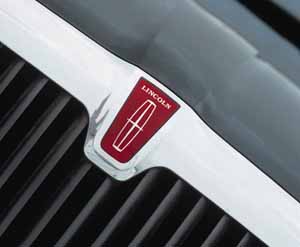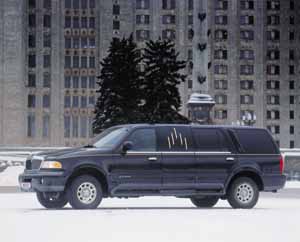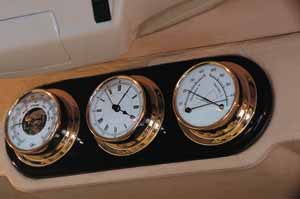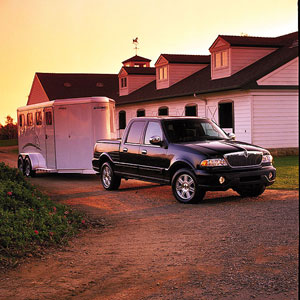Test drive Lincoln Navigator 1998 - 2003 SUV
A car for two
 More relatively recently in the USA (mainly in the southern states) there was a fashion for tourist buses converted for the transportation of a single passenger. It's not about kempers and not about houses on wheels, owners of which are most often not very wealthy people. Vice versa. Some kind of a resident of Texas (where everything is the largest in the world), not satisfied with the level of comfort, which provided him with the rear sofa of a representative limousine, ordered a bus for five stars. Please! At the request of the client, a specialized workshop could equip an office, a dining room, a compartment for meetings, a bedroom, or even a pool in a multi -ton -tank colossus.
More relatively recently in the USA (mainly in the southern states) there was a fashion for tourist buses converted for the transportation of a single passenger. It's not about kempers and not about houses on wheels, owners of which are most often not very wealthy people. Vice versa. Some kind of a resident of Texas (where everything is the largest in the world), not satisfied with the level of comfort, which provided him with the rear sofa of a representative limousine, ordered a bus for five stars. Please! At the request of the client, a specialized workshop could equip an office, a dining room, a compartment for meetings, a bedroom, or even a pool in a multi -ton -tank colossus.  Such buses - unlike campers - were used not for living, but only for trips, and at short distances (crossing the country and even the staff is still much more convenient by train or plane).
Such buses - unlike campers - were used not for living, but only for trips, and at short distances (crossing the country and even the staff is still much more convenient by train or plane). Gigantomania quickly came to naught - mainly due to restrictions in the rules of the road: huge cars were prohibited from entering the business part of most cities. But the idea of \u200b\u200busing large chassis for the construction of limousines has not died.
Here, the SUVs began to gain popularity here, and the designers of mobile apartments turned eyes to the largest of them - full -size. Of course, you can’t stick a kitchen or a bedroom into the SUV, but it was possible to increase the comfort of the serial machine of those years.
Gradually, the automakers themselves began to produce more and more luxury versions, the demand for individual services of tuning firms began to fall, and with the loss of customers many of them ceased to exist or changed their profile. But not all. There were still lovers of exclusive cars, there are various studios and design studios, engaged in finishing the already supercomfortable machines. The source material for them is quite often served by Lincoln Navigator, based on the F-150 truck platform (motor # 11, 1997).
Recently, such a car was in our editorial office - Navigator, almost completely trimmed in Russia. Almost - because the body work and the modification of the transmission were performed in America.
Somewhere in Pennsylvania, a specialized company lengthened a 950 mm frame, and in a body cut across the body welded a dull insert. The vertical strips-backlines on it (five on each side) impose a minor mood with their appearance. If in their place, the windows, even if strato, would look more logical and elegant, but, apparently, the client wished, or maybe the fantasy of the American tuningers did not go beyond the iron sheet. The resulting, the wagon resulting in externally loses to the standard Navigator. However, such flashlights in stretchs for some reason are considered a good tone.
Leaves much to be desired and quality of execution. On a careful examination, it is clear that the vertical gaps between the insert and doors in the upper and lower parts are uneven. We already had to deal with piece American machines built with quality far from the reference - so we are not surprised. In addition to lengthening, the body has not undergone any changes.
During the modification of the car, they abandoned the idea of \u200b\u200busing it on off -road - serially installed on Navigator, the controlled suspension is reconfigured in such a way that it provides the body with a horizontal position, but does not change the road clearance.
The driver's compartment remained standard - like a conveyor machine. It was the compartment that the partition appeared behind the backs of the front seats (as in the limousine), in which you can close the tinted glass and panel covered with skin.
 The main, passenger, compartment is stylized under the cabin of the yacht and stood in light colors - apparently, for contrast with a black body. The sea theme is reflected by three ship devices in the upper part of the front partition - a hygrometer, a clock and a barometer. The rest of the equipment is quite land. The central console has a TV with a 14-inch screen, a video recorder and a radio.
The main, passenger, compartment is stylized under the cabin of the yacht and stood in light colors - apparently, for contrast with a black body. The sea theme is reflected by three ship devices in the upper part of the front partition - a hygrometer, a clock and a barometer. The rest of the equipment is quite land. The central console has a TV with a 14-inch screen, a video recorder and a radio.  A huge salon is designed for only two passengers - for them there are separate chairs. Another seat - a small folding seat - is located on the left to the front, but it is very uncomfortable and is used only in emergency cases. Together with the car, the sofa arrived from America - for installation in the cabin, but the customer did not like it. Russian designers proposed replacing the sofa with the front chairs from Lincoln Town Car. There were problems with their installation - it turned out that the electric drives of adjustments are very bulky. The chairs either got too high (the floor in the back of the navigator was raised), or turned out to be too shifted forward and overlapped part of the doorway, which deprived the presence of an elongated body.
A huge salon is designed for only two passengers - for them there are separate chairs. Another seat - a small folding seat - is located on the left to the front, but it is very uncomfortable and is used only in emergency cases. Together with the car, the sofa arrived from America - for installation in the cabin, but the customer did not like it. Russian designers proposed replacing the sofa with the front chairs from Lincoln Town Car. There were problems with their installation - it turned out that the electric drives of adjustments are very bulky. The chairs either got too high (the floor in the back of the navigator was raised), or turned out to be too shifted forward and overlapped part of the doorway, which deprived the presence of an elongated body. I had to dismantle electrical mechanisms - now you have to carry out all the adjustment manually (though there is no real need for this). The feeling of passengers will not visit - the central armrest is wide enough. In its upper part there is a telephone, as well as the panel control panels of a television-video-equipment and a salon climate.
 Opposite the left armchair is a bar-chronicle. Its folding door can be used as a table. All internal panels are covered with leather, which will diversify narrow wooden inserts. Above the TV and under the bar are plastic grilles of the air conditioning and heater deflectors. The floor of the cabin is covered with a darker carpet compared to the rest of the tone.
Opposite the left armchair is a bar-chronicle. Its folding door can be used as a table. All internal panels are covered with leather, which will diversify narrow wooden inserts. Above the TV and under the bar are plastic grilles of the air conditioning and heater deflectors. The floor of the cabin is covered with a darker carpet compared to the rest of the tone. Behind the backs of the seats - to the fifth door - the horizontal regiment was proved, under which a 700 -watt subwoofer, two amplifiers and a CD changer capable of twisting and video disks are hidden. The main speakers are mounted in the regiment, the rest are in the doorway and front wall.
What is hidden under the luxurious sheathing of the salon? What did the qualified brigade of the interior masters needed seven months of painstaking work?
We were shown photos taken upon the arrival of a car to Moscow. They can clearly see complete devastation in the rear, passenger part - naked iron, welded seams, wire harnesses ...
 The client, as it turned out, was rather vaguely imagined what he needed. Some of his desires were generally impossible to install on a car, others demanded serious alterations. As a result, only the approval of the project with the customer took five weeks ...
The client, as it turned out, was rather vaguely imagined what he needed. Some of his desires were generally impossible to install on a car, others demanded serious alterations. As a result, only the approval of the project with the customer took five weeks ... First of all, the nervouss were mounted - special ribs, which are at some distance from body panels and serving for the installation of internal casing. First, the nervouss put steel, welded, then they were replaced by aluminum, fastened rivets. From the inside, the entire body was pasted with soundproofing material. Installed frames for equipment and seats, guides for glass in the partition, laid the wiring and pipelines of air conditioners. There are two of them in the car: one serves the driver’s compartment, the other is passenger. The layout of the additional air conditioner was unsuccessful, I had to take out the fan electric motors and cover the main highway with sound insulation - when the air is turned on, it buzzed like an organ.
 The sheathing of the cabin is made of a mosquito - two -layer sheet plastic, which is easily formed during heating. To get rid of visible fasteners, there are special latches and pistons on the inside of the panels. It is impossible to disassemble the salon, not knowing exactly where to click and what to pick up, and not to break anything at the same time - it is impossible. Plastic sheets are covered with leather, under which elastic gaskets creating relief are laid in places. The ceiling of the cabin is excited of fiberglass. A distance of a few centimeters, necessary for placing the hatch mechanism, was left between it and the roof.
The sheathing of the cabin is made of a mosquito - two -layer sheet plastic, which is easily formed during heating. To get rid of visible fasteners, there are special latches and pistons on the inside of the panels. It is impossible to disassemble the salon, not knowing exactly where to click and what to pick up, and not to break anything at the same time - it is impossible. Plastic sheets are covered with leather, under which elastic gaskets creating relief are laid in places. The ceiling of the cabin is excited of fiberglass. A distance of a few centimeters, necessary for placing the hatch mechanism, was left between it and the roof. After the car’s interior was completely mounted, the car was mercilessly driven along the worst roads, trying to shake the interior. As a result, it turned out that some improvements were required.
 At the insistence of the client, the car was installed not by car, but the usual - 220 -volt - a TV and a video recorder. The desired voltage is provided by the 12/220 converter, which issues 1 kW. For its power, under the hood there are more powerful than on the basic version, a generator and two batteries. The latter are made in America using some kind of space technology, and with dimensions that are not much superior to ordinary, have a capacity of 700 and 1000 Ah. By the way, the converter also works in the opposite direction, so it can be used to charge batteries - right from the outlet in the garage.
At the insistence of the client, the car was installed not by car, but the usual - 220 -volt - a TV and a video recorder. The desired voltage is provided by the 12/220 converter, which issues 1 kW. For its power, under the hood there are more powerful than on the basic version, a generator and two batteries. The latter are made in America using some kind of space technology, and with dimensions that are not much superior to ordinary, have a capacity of 700 and 1000 Ah. By the way, the converter also works in the opposite direction, so it can be used to charge batteries - right from the outlet in the garage. There is also a pre -heater with a timer working on gasoline - at a given time a warm car will wait for you.
Numerous additional equipment ate the space in the cabin - there was no place for baggage. If you open the back, fifth door, only aluminum ribs of electrical equipment and a tiny niche for tools are visible to the bottom right. The spare wheel is left in the regular place - outside in the rear overhang ...
 The inspection is completed, it's time to get in the cabin. Yes, in the passenger salon, since the main in this car is clearly not a driver. Moreover, Lincoln Navigator’s running qualities have already been well studied by us.
The inspection is completed, it's time to get in the cabin. Yes, in the passenger salon, since the main in this car is clearly not a driver. Moreover, Lincoln Navigator’s running qualities have already been well studied by us. The door opens widely, there is a bandwagon under the threshold - for such a high car, the landing is quite convenient. Having sank into the softest chair and closing the door, I begin to feel at home. The sounds of an outer life penetrate the salon - you sit, as a wrapped in cotton wool. He clicked the keys on the armrest. The mechanisms that open the hatch and windows work silently. I turned on the radio - numerous speakers came to life. Sortering the ranges, accidentally hit the rap. The subwoofer swelled into the back of the head so that the lower classes had to be removed urgently. Now - TV. Thanks to the strong tinting of the glasses in the cabin, it is quite dark even on a clear day - the screen does not glance, the image is clear. In motion, however, the technique is very unstable, therefore it is preferable to watch a video.
I lower the glass in the partition - to communicate with the driver. The car is smoothly touched, unfolds, accelerates sharply ... We are in the traffic flow. Almost nothing is visible through the side glasses - even with the curtains drew, it is not interesting to watch the road through the narrow window between the salons. I raise the opening - I raise the glass and after it is an opaque partition. Now you can concentrate on your own sensations. The car moves softly, sways a little sometimes on the irregularities of the road. Turns, accelerations and braking are felt only through the vestibular apparatus - there are no body rolls. Lincoln Navigator, even in standard configuration, is famous for smoothness, and even having an elongated base, is quite capable of competing with Rolls-Royce.
Complete isolation from the outside world and small swaying lull - it begins to seem that you are on a ship, a furrowing water surface. The sea interior only enhances this impression. I relaxed so much that I didn’t even get behind the wheel - I carefully enjoyed comfort until the very end of the trip and left the car with great regret.
 Frankly, going to get acquainted with the car, I was skeptical. Not in relation to him - rather, the very idea of \u200b\u200bhis alteration seemed doubtful. As a result, the modernized Navigator made a great impression. The goal that experts set for themselves is to build an extremely comfortable car - achieved.
Frankly, going to get acquainted with the car, I was skeptical. Not in relation to him - rather, the very idea of \u200b\u200bhis alteration seemed doubtful. As a result, the modernized Navigator made a great impression. The goal that experts set for themselves is to build an extremely comfortable car - achieved. Of course, there are some disadvantages - for example, a broken lower grate of the duct in the cabin (probably someone touched your foot), or a slightly peeled off - at the top of the fifth door, but, given the volume and results of the work done, you can not turn to these trifles. attention.
Evgeny Romantovsky
Source: Magazine Motor







